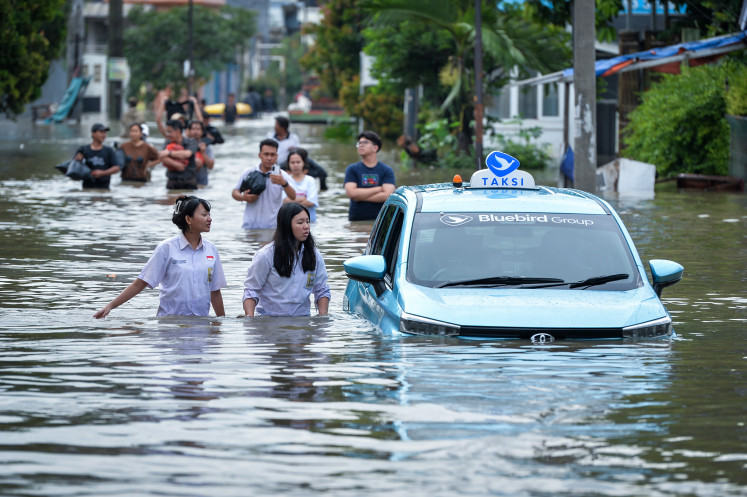Popular Reads
Top Results
Can't find what you're looking for?
View all search resultsPopular Reads
Top Results
Can't find what you're looking for?
View all search resultsGovt halts creative district plan, focuses on ‘creative hubs’
The government plans to develop “creative hubs” at super-priority tourist destinations to add value to regional economies, putting on the shelf an earlier plan by the now-defunct Creative Economy Agency (Bekraf) for creative districts across Indonesia
Change text size
Gift Premium Articles
to Anyone
T
he government plans to develop “creative hubs” at super-priority tourist destinations to add value to regional economies, putting on the shelf an earlier plan by the now-defunct Creative Economy Agency (Bekraf) for creative districts across Indonesia.
The Tourism and Creative Economy Ministry, which has taken over Bekraf’s role, seeks to create centers of creative excellence that would explore and nurture each region’s creative economy potential, such as crafts, cuisine, fashion and performing arts.
“We have been working with the Public Works and Housing Ministry in establishing the creative hub in Pusat Waringin, Labuan Bajo, East Nusa Tenggara,” Tourism and Creative Economy Minister Wishnutama Kusubandio told the press on Jan. 8.
He said the ministry was building creative hubs around Lake Toba (North Sumatra), Borobudur temple and Semarang old town in Central Java.
Indonesia is turning toward creative economy, tourism and digital economy as new economic engines as gross domestic product (GDP) grew the least in more than two years. The creative economy contributed 7.4 percent to Indonesia’s GDP in 2016, with growth expected to reach 9.6 percent in 2019 to top Rp 1.2 quadrillion (US$87.14 billion), according to Bekraf.
“As for the plan for creative districts, I still need to study that,” he said, referring to Bekraf’s earlier plan to establish Bekraf Creative Districts (BCD) last year, which would be the first districts dedicated to the development of creative industries.
BCD is one of the Strategic Priority Projects in the 2020-2024 National Medium-Term Development Plan.
Former Bekraf deputy head Ricky Joseph Pesik told The Jakarta Post in July that the agency was formulating the plans and policies by the end of last year and hoped to work on the project this year. That was before President Joko “Jokowi” Widodo decided to merge Bekraf with the Tourism and Creative Economy Ministry for his second term that started in October.
A BCD was originally planned to be built on about 5,000 hectares of land just outside of the capital, at a cost of more than Rp 100 trillion, according to the agency’s former head, Triawan Munaf.
“The BCD is one of the agenda items inscribed in the government’s 2018 to 2025 master plan for creative economy development, intended for a new integrated ecosystem of the country’s creative industries,” he said during a seminar on creative entrepreneurship in Jakarta that was also in July.
However, creative economy observers and industry players were left wondering how a BCD would incentivize and attract industry players to ultimately boost the creative industry’s performance.
“Will the creative businesses receive tax incentives or easier market access if they move to the district? The government needs to address this,” said cofounder and vice deputy of international relations at the Indonesian Creative Cities Network, Felencia Hutabarat.
She said cities would actually gain benefits from having scattered creative centers. For example, as West Jakarta has the Gedung Kesenian Jakarta theater hall, the government can make it a performance art center.
“It can be a trademark for the area,” Felencia said. “Another important factor to be considered is how the residents can be involved and benefit from the presence of the creative district.”
The Indonesian Fashion Designers and Fashion Entrepreneurs Association (APPMI) asserted that while a BCD would be a major project and would take time to adjust to, the government had not reached out to the industry players.
“We suggest that the government conduct a deep study on how industry players will be transferred to the city. It will not be easy since some players, including myself, have other jobs besides doing what they do in the industry,” said APPMI founder and chairperson Poppy Dharsono.
Meanwhile, Monique Soeriaatmadja, the owner and creative director of fashion brands SOE Jakarta and alex[a]lexa, said that a BCD would be an interesting place for industry players if the government could provide advanced facilities in it.
“The fashion industry is now expected to adapt to new costly technologies. It will be great if the planned creative city is equipped with technologies that can help improve our creative processes and further enhance the fashion industry,” she said.
For example, she said, it would be compelling for local fashion designers if the government could provide facilities to access important information such as fashion trend references, since subscriptions to world-class trend forecasting agencies were costly for owners of small brands










